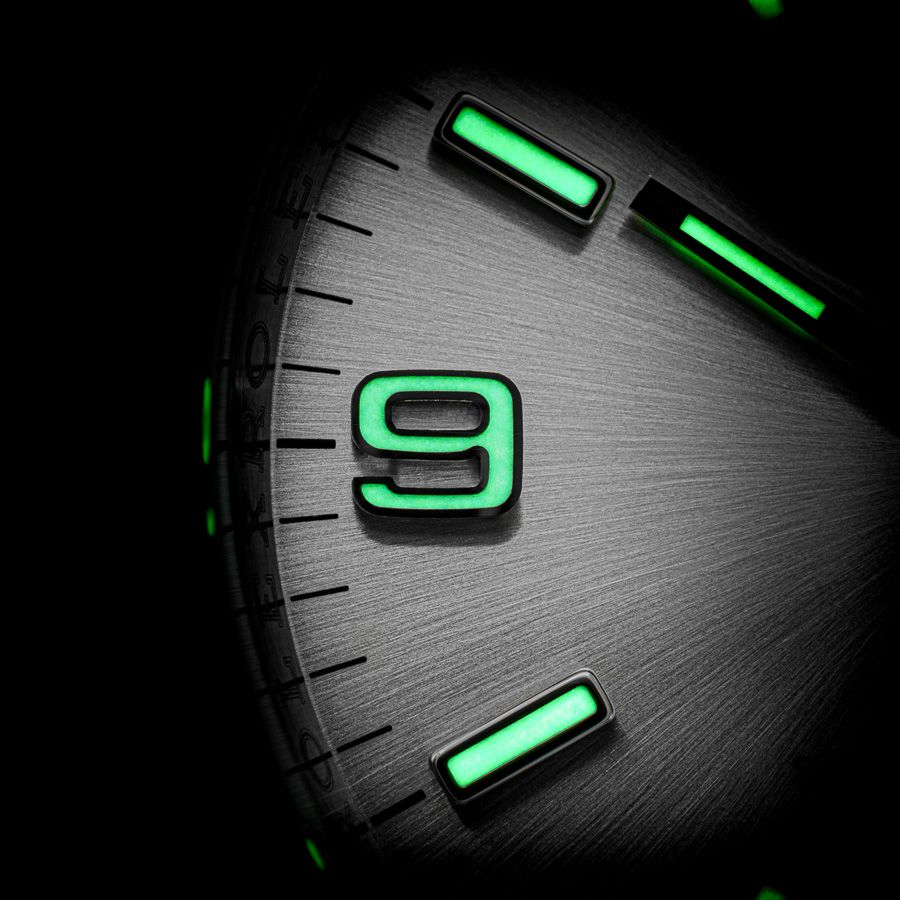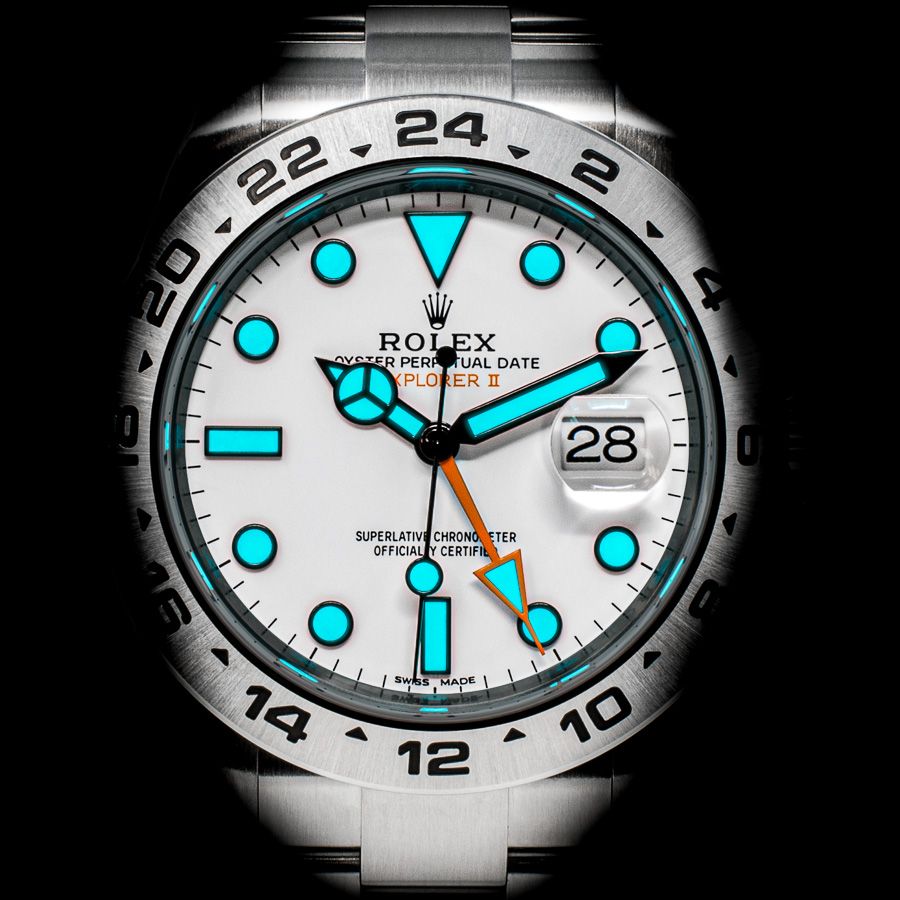Holding a piece of horological history that quite literally glows with the story of human innovation and safety consciousness is deeply fascinating. When you examine a vintage Rolex under UV light, you're not just looking at luminescent material—you're witnessing decades of technological evolution driven by both ambition and necessity.
Rolex has long been known for its commitment to innovation, particularly when it comes to luminescence in watches. What began as a quest for visibility in darkness became a journey through some of the most significant safety advancements in watchmaking history. From the early days of radioactive radium to today's brilliant Chromalight, each transition tells a story of technological progress and growing awareness of worker and wearer safety.
Key Evolutionary Milestones
- Radium Era (Pre-1953-1963) – The dangerous beauty of highly radioactive luminescence
- Tritium Transition (1963-1997) – Lower-energy radioactivity with sophisticated dial markings
- LumiNova Revolution (1998-2008) – Complete elimination of radioactivity through photoluminescent innovation
- Chromalight Mastery (2008-present) – Rolex's proprietary blue-glowing compound lasting up to 8 hours


Rolex Oyster Perpetual 116000 with the Green Super-LumiNova
The Dangerous Beauty of Radium's Glow
The story begins in an era when the dangers of radioactivity were poorly understood. Prior to 1953, Rolex embraced radium for its remarkable luminescent properties on pocket watches, early Oyster cases, and those coveted bubble-back models. Radium paint workers, often young women, would literally lick their brush tips to create fine points for precision application—a practice that led to devastating health consequences as the material's dangers became apparent.
From 1953 to 1956, Rolex introduced the world to their revolutionary sports watch concept with the radium-lumed Submariner, Turn-O-Graph, Explorer, and GMT-Master. These tool watches represented a paradigm shift in horology, but they carried an invisible threat that would soon force the industry to evolve.
Recognizing mounting health concerns, Rolex began reducing radiation levels between 1957 and 1960, transitioning from single to dual-colored dial printing while enhancing lacquer to a glossier finish. The period from 1960 to 1963 marked the true "transitional" era, featuring the distinctive exclamation mark dials as international regulations began demanding safer luminescent materials.
Tritium's Measured Safety Evolution
The transition from radium to tritium beginning in 1963 represents one of the most carefully documented changes in Rolex's history. Those transitional 1963-1964 dials are particularly fascinating to collectors—marked "Swiss" but laminated with tritium, they represent the exact moment when Rolex prioritized safety over familiarity.
From 1964 to 1967, we see the emergence of those iconic tritium markings: "Swiss - T<25" and "T-Swiss-T" appearing on glossy dials as Rolex embraced full transparency about their luminescent materials. The matte dial era from 1967 to 1983 brought variations like "T Swiss T<25" and the distinctive "o T-Swiss-T o" markings that collectors prize today.
Tritium's final act came between 1983 and 1997, when glossy dials returned with luminous material applied in elegant white gold surrounds—a sophisticated solution that maintained legibility while showcasing Rolex's advancing metallurgical expertise.


Rolex Datejust 36 16203 with Tritium
The Photoluminescent Revolution
In 1998, everything changed. Rolex partnered with Nemoto & Co. to implement LumiNova—a revolutionary strontium-aluminate compound that eliminated radioactivity entirely. This photoluminescent material could be charged by natural or artificial light, storing energy and releasing it gradually for hours of visibility.
The swift transition to Super-LumiNova in 2000 demonstrated Rolex's commitment to continuous improvement. This enhanced version provided brighter, longer-lasting illumination while maintaining complete safety for workers and wearers alike. The green glow of Super-LumiNova became the new standard, offering immediate brightness that gradually faded over 3-4 hours.


Rolex Yacht-Master 116622 with Green Super-LumiNova
Chromalight's Blue Breakthrough
2008 marked Rolex's boldest luminescent innovation yet: Chromalight. This proprietary blue-emitting compound doesn't just match Super-LumiNova's performance—it surpasses it dramatically. Lasting up to 8 hours (roughly double its predecessor), Chromalight offers superior longevity while being gentler on night-adapted vision.
Interesting Details:
- Blue light preserves night vision better than green
- The compound charges faster and holds energy longer
- Chromalight's unique formulation is exclusive to Rolex
- The material performs consistently across decades without degradation


Rolex Explorer II 216570 with Blue Chromalight
Why Blue Conquers Green
The shift from green to blue wasn't merely aesthetic—it was scientific. While Super-LumiNova's green initially appears brighter to the human eye, Chromalight's blue glow maintains superior legibility over extended periods. Blue light is less disruptive to the eye's dark adaptation, making it ideal for professional tool watch applications where preserving night vision is crucial.
Technical Innovation Meets Safety Consciousness
Design Philosophy: Each luminescent evolution reflects Rolex's fundamental understanding that true innovation serves both performance and human welfare. The journey from radioactive radium to safe, long-lasting Chromalight represents more than technological advancement—it's a story of corporate responsibility.
Modern Chromalight represents the culmination of nearly a century of luminescent development. Unlike its radioactive predecessors, this photoluminescent material poses no health risks while delivering superior performance. The compound's strontium-aluminate crystals absorb and store light energy efficiently, then release it gradually for hours of consistent visibility.
The Illuminated Path Forward
Rolex's luminescent journey from radium to Chromalight illustrates how innovation and responsibility can drive extraordinary advancement. What began as a dangerous pursuit of visibility in darkness evolved into a masterclass in safe, sustainable engineering. Today's Chromalight-equipped Rolex represents the perfect marriage of performance and safety—a glowing testament to seven decades of continuous improvement.
For those wearing vintage tritium Rolexes today, that faint toast-colored patina and gentle glow tells a story of transitional innovation. For modern Rolex owners, Chromalight's brilliant blue luminescence represents the current pinnacle of safe, sustainable luminescent technology.
This evolution reminds us that the best innovations often come not from pursuing performance alone, but from the wisdom to prioritize human welfare alongside technological advancement. In watchmaking, as in life, progress means more than just moving forward—it means moving forward responsibly.
FREQUENTLY ASKED QUESTIONS
- When did Rolex stop using radium lume?
Rolex completed its transition away from radium by 1963, replacing it with safer tritium across all new dial production. - Does Chromalight ever wear out?
Not in normal use. Because it's photoluminescent rather than radioactive, its glow depends entirely on light absorption. With proper exposure, Chromalight should perform consistently for decades. - Can my vintage tritium Rolex still glow?
Aged tritium typically emits only a faint toast-colored patina with minimal nighttime visibility after 25–30 years. This aging is normal and often prized by collectors for its vintage authenticity. - Is Super-LumiNova still used on any current Rolex models?
No. Since 2008, Rolex has equipped all new references exclusively with Chromalight. Super-LumiNova remains common across many other Swiss manufacturers. - How do I charge Chromalight or Super-LumiNova for maximum brightness?
Expose the dial to bright natural sunlight or a strong LED flashlight for 10–20 seconds. The strontium-aluminate crystals will store this light energy and release it gradually in darkness.




